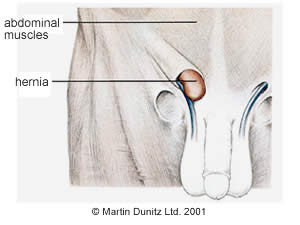| ommon Signs & Symptoms | |||||
| Pain | Swelling | Stiffness | Weakness | Instability | Locking |
Inguinal Hernia Injury Explained
Hernia and groin problems are common sports injuries, particularly in football (soccer) where the pelvic region is subject to large torsional (twisting) loads. An Inguinal Hernia refers to a protrusion of the abdominal contents through a weakness in the connective tissue of the Inguinal Canal.
The Inguinal canal is the region between the abdomen and inner thigh, through which the testes (or the round ligament in females) descend during childhood. The Inguinal region is a weak point in the abdominal wall. The weak point results from the fact that the spermatic cord passes through this canal in men and the ligament of the uterus passes through it in women.

Prior to a true Inguinal Hernia, the abdominal muscle layers can become elastic as a reaction to extreme strains in this region due to work and sports activities. The resultant pressure on the nerves passing through that region particularly the Genitofemoral nerve, can cause severe pain that can radiate to the upper thigh and the testes.
Inguinal Hernia Signs & Symptoms
Following sporting activity, someone with an Inguinal Hernia will be stiff and sore. Typically, the day after a football match for example, getting out of bed or a car will be uncomfortable. Any exertion that increases intra-abdominal pressure, such as coughing, sneezing or sporting activity can cause pain. In the early stages, the person may be able to continue playing their sport but the problem usually gets progressively worse.
Pain in the groin and pelvis can be referred from a number of problems, including injuries to the lower back, the hip joint, the Sacro-Iliac joint, the abdomen and the genito-urinary system. Therefore, diagnosis of an Inguinal Hernia requires skilful differentiation.
Because it requires an expert to diagnose an Inguinal Hernia it is not unusual for many weeks or months to pass before the correct diagnosis is made. In those people who have typical Inguinal Hernia symptoms, an expert can confirm the diagnosis with physical tests and an Ultrasound scan.
Inguinal Hernia Treatment
What you can do
| Consult a sports injury expert | |
| Wear Compression Shorts whilst waiting for surgery |
Conservative treatment with a Chartered Physiotherapist involves stabilising and strengthening the muscles of the pelvic region, which can effectively decrease the workload on the affected area, but this rarely cures the problem. In most cases it is usually possible to continue doing sports while wearing Warm Pants (Compression Shorts), until an opportune time can be arranged for surgery. Usually, there comes a time when the person can no longer continue because sports performance becomes so impaired. A surgical approach is usually required.
The surgical treatment of Inguinal Hernias has been revolutionised over the past ten years. The world’s top hernia surgeons now perform hernia surgery under local anaesthetic. Depending on the individual circumstances of the patient, considering their age, occupation, general health and the size and degree of the Inguinal Hernia, the surgical technique is chosen which is ‘tailored’ to the patient’s situation.
A Minimal Repair technique has been pioneered by Dr Ulrike Muschaweck, at the Hernia Center Munich. This sparing technique doesn’t use a surgical ‘mesh’ to repair the hernia and only the affected tissues are repaired. This means that the person can resume strenuous exercise after just two days, making it the ideal repair for athletes.
‘Mesh’ techniques have been developed for patients who have large defects in the wall of the Inguinal canal or for older patients where the abdominal wall is weak. A square surgical mesh is stitched onto the muscle layers of the abdominal region in order to repair the hernia.
The Minimal Repair is a mesh free technique which is used for patients who have a big defect in the fascia of the Inguinal canal, while the muscle layers are still intact. Physical immobility is not required and the patient can begin physical work a few days after surgery.
The principle of local anaesthesia is pain elimination by blocking the nerves in the groin region with a pain-free injection. This is different from spinal anaesthesia, such as an epidural injection. The advantages of a local anaesthetic are that the patient is able to get up on their feet straight after the operation and there is no need for an overnight stay in hospital. Patients can usually eat immediately after surgery, as they don’t experience the side effects of a general anaesthetic like nausea and vomiting, headaches and urinary retention.
Because these side effects are eliminated and the surgical repair is so unobtrusive, the rehabilitation process can begin immediately. Patients are encouraged to return to everyday activities and work the day after surgery. The patient can resume gentle exercise such as jogging or cycling. Elite athletes can begin sprinting after three or four days. Within five or six days there are no physical restrictions. Premiership footballers typically return to action after 7 to 10 days following surgery with Dr Ulrike Muschaweck at the Hernia Center Munich.
Inguinal Hernia Prevention
What you can do
| Use a Swiss Ball for Core Strengthening Exercises | |
| Use resistance bands for Core Strengthening Exercises |
Core Strength and Core Stability exercises can improve muscle function across the trunk and pelvis, reducing the likelihood of a hernia. Core strength exercises on a mat and using a Swiss Ball or Resistance Bands are ideal, because the improved muscular strength around the Gluteal and Abdominal muscles enhances stability and can help to counteract the large forces that are applied to the lower abdomen and pelvis. This can reduce the risk of developing a hernia. Core strengthening is vital for anybody playing sport as it is a natural protection mechanism against many injuries.


